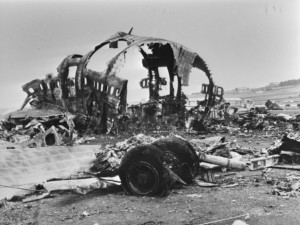 Leaders not only make decisions, but also have a large impact on the mood and the culture in a company. Often, they like to be right. Yet, they are only humans, they don’t know everything, and they do make mistakes. Hence, a good culture for disagreement is important to make better decisions. In this post I would like to talk more about the value of disagreement, and why it is not common to find it in industry.
Leaders not only make decisions, but also have a large impact on the mood and the culture in a company. Often, they like to be right. Yet, they are only humans, they don’t know everything, and they do make mistakes. Hence, a good culture for disagreement is important to make better decisions. In this post I would like to talk more about the value of disagreement, and why it is not common to find it in industry.
Analogies from Aviation
Tenerife Airport Disaster
 October 27, 1977 was a busy day at the Tenerife airport, despite heavy fog and low visibility. Due to the closure of another airport, many aircraft were diverted, the taxiway was filled up with planes, and planes had to use the runway to get into starting position. In this environment, a Pan Am Boeing 747 was just about to leave the runway back to the taxiway, when a KLM Boeing 747 started to take off. The crash caused the loss of 583 lives.
October 27, 1977 was a busy day at the Tenerife airport, despite heavy fog and low visibility. Due to the closure of another airport, many aircraft were diverted, the taxiway was filled up with planes, and planes had to use the runway to get into starting position. In this environment, a Pan Am Boeing 747 was just about to leave the runway back to the taxiway, when a KLM Boeing 747 started to take off. The crash caused the loss of 583 lives.
Many factors came together to cause this accident, from bad weather to ambiguous communication. But there was also a hierarchical barrier for disagreement in the KLM cockpit. The captain of the KLM plane was a highly respected captain, but was a bit in a rush to take off. Both the co-pilot and the flight engineer at different times voiced hesitation and concern that the runway was not yet clear, yet they were snubbed by the captain. Again, this was not the only cause of the catastrophe, but if the captain would have listened to the co-pilot and flight engineer, disaster could have been avoided.
Korean Air Flight 801
 Korean Air Flight 801 crashed on August 6, 1997 near Guam. Heavy rain and low visibility required an instrument landing. However, the instrument landing system at the runway was out of service. The captain though he picked up a signal. The crew disagreed, and the flight engineer later also protested that the descend was too steep and said multiple times that there is no airport in sight. Yet, the captain pressed on and crashed into a hill, leading to the death of 229 of the 254 occupants of the plane.
Korean Air Flight 801 crashed on August 6, 1997 near Guam. Heavy rain and low visibility required an instrument landing. However, the instrument landing system at the runway was out of service. The captain though he picked up a signal. The crew disagreed, and the flight engineer later also protested that the descend was too steep and said multiple times that there is no airport in sight. Yet, the captain pressed on and crashed into a hill, leading to the death of 229 of the 254 occupants of the plane.
United Airlines Flight 173
 When United Airlines Flight 173 was approaching Portland in December 28, 1978, they encountered a problem with the landing gear. The pilot entered a holding pattern to resolve the problem, circling for over one hour. The first officer and flight engineer indicated that they were running low on fuel, but the captain reacted too late. Ten people died in the resulting crash.
When United Airlines Flight 173 was approaching Portland in December 28, 1978, they encountered a problem with the landing gear. The pilot entered a holding pattern to resolve the problem, circling for over one hour. The first officer and flight engineer indicated that they were running low on fuel, but the captain reacted too late. Ten people died in the resulting crash.
The Aviation Response: Crew Resource Management
 In response in particular to the Tenerife disaster, and later to the United Airlines Flight 173 crash, aviation regulations started to train for crew resource management. The goal is to provide a free exchange of information among the crew and to reduce the power distance. Crew members are trained to voice their concerns and to hear the concerns of others regardless of the level of hierarchy. They aim to improve interpersonal communication, leadership, and decision making. It is nowadays a mandatory training at most airline regulation bodies. Crew resource management expanded from aviation also to many other fields, like shipping, firefighting, and medicine, although the quality of the implementation varies.
In response in particular to the Tenerife disaster, and later to the United Airlines Flight 173 crash, aviation regulations started to train for crew resource management. The goal is to provide a free exchange of information among the crew and to reduce the power distance. Crew members are trained to voice their concerns and to hear the concerns of others regardless of the level of hierarchy. They aim to improve interpersonal communication, leadership, and decision making. It is nowadays a mandatory training at most airline regulation bodies. Crew resource management expanded from aviation also to many other fields, like shipping, firefighting, and medicine, although the quality of the implementation varies.
How About Manufacturing?
 At this point, you are probably wondering if this can be applied to manufacturing. Definitely. If you are working in manufacturing, you probably know plenty of examples when people knew that something would not work, but either did not dare speak up or if they spoke up they were not heard. The all-knowing decision maker put more trust in his own opinion than his underlings’, and the (for all but one) predictable outcome happened. A manufacturing version of crew resource management could definitely help.
At this point, you are probably wondering if this can be applied to manufacturing. Definitely. If you are working in manufacturing, you probably know plenty of examples when people knew that something would not work, but either did not dare speak up or if they spoke up they were not heard. The all-knowing decision maker put more trust in his own opinion than his underlings’, and the (for all but one) predictable outcome happened. A manufacturing version of crew resource management could definitely help.
The Challenge in Manufacturing

However, it is a bit more difficult in manufacturing than in aviation (although not impossible). In aviation, a crew works together for long hours, they know each other, and they have plenty of opportunity for human interaction. It is also much less a question of outdoing someone else to get promoted. In manufacturing, this can be quite different. An upper-level manager may spend quite some time with the level below him, but the farther down you go in hierarchy, the less actual contact the manager has with the people.

At one point, another employee is no longer seen as a person, but merely a number. This is also called the monkey circle. Bands of monkeys can have up to fifty members; after that frictions increase and the groups tend to split, since a monkey can no longer really know his peers. For humans, it is estimated that we have around 150 people with whom we truly have a relationship; everybody else is just a statistic.
The larger number of people involved combined with a higher pressure on looking promotable often hinders open communication. What one side considers a helpful suggestion may be seen as a personal attack by the other side. On top of that is my opinion that, especially higher up, you will find a lot of managers that need the feeling of power and supremacy. And, it is a well known fact that there is a much higher likelihood to find a psychopath in management than in the general population.
How to Do Crew Resource Management

The goal of crew resource management is clear: voice your opinion (respectfully) and listen to others. However, telling someone to “just do crew resource management” won’t really help. One key part is for the person in the lower hierarchy to know how to communicate an issue politely and respectfully.
How to Raise an Issue
Below are five key steps, copied from the Wikipedia article on crew resource management, which look like a good approach to me:
- Opening or attention getter – Address the individual: “Hey Chief,” or “Captain Smith,” or “Bob,” or whatever name or title will get the person’s attention.
- State your concern – Express your analysis of the situation in a direct manner while owning your emotions about it. “I’m concerned that we may not have enough fuel to fly around this storm system,” or “I’m worried that the roof might collapse.”
- State the problem as you see it – “We’re showing only 40 minutes of fuel left,” or “This building has a lightweight steel truss roof, and we may have fire extension into the roof structure.”
- State a solution – “Let’s divert to another airport and refuel,” or “I think we should pull some tiles and take a look with the thermal imaging camera before we commit crews inside.”
- Obtain agreement (or buy-in) – “Does that sound good to you, Captain?”
Common Sender Errors
There are also a few common mistakes both for the receiver and the sender of the information. Also from Wikipedia, here are common sender errors:
 No frame of reference – If the receiver is missing context for the message, they are less likely to understand accurately.
No frame of reference – If the receiver is missing context for the message, they are less likely to understand accurately.- Omission of information – The sender neglects to clarify important parts of the message, leaving ambiguity.
- Inserting bias – The sender inserts a personal opinion into a message that should be unbiased facts. This can cause the message to seem less trustworthy, or mislead the receiver about critical facts.
- Ignoring body language – It is quite possible to send an unintended message with body language and tone, or lack thereof in a medium that does not properly convey it.
- Being unwilling to repeat information – Especially in the presence of distraction, it is easy for a receiver to miss something important.
- Disrespectful communication – It is hard to think logically about a message presented in a hostile way.
Common Receiver Errors
And finally, here are the common mistakes by the receiver:
- Listening with prejudice – If the listener’s mind is already made up before the sender speaks, vital details may be missed.
- Poor preparation – Listening is an active and conscious process that must be treated as such.
- Thinking ahead of the sender – Extrapolating, putting words in the sender’s mouth. The sender saying “Hear me out!” may be a sign of this.
- Ignoring nonverbal cues – Failure to understand the full intended effect of the message.
- Failure to ask for clarification – When in doubt, rather than try to guess what the sender means, simply asking can be a lot more effective.
- Disrespectful communication – Replying with a knee-jerk insult will degrade communication.
Now, go out, talk, and especially LISTEN to people, and organize your industry!

I truly believe that the more communication in the workplace the better, solutions should be encouraged to be a team effort throughout the whole chain of command. However, I also recognize some of the issues your article suggests throughout about hierarchy. Your addition of the “How to raise an issue”, sender errors, and receiver errors is a great learning tool that although may seem basic to the reader these skills can be often difficult to recognize during a real situation and makes the reader far more aware of their actions. I will be taking what I have read here and see how it is represented in my personal and professional life.
Ellen, I Almost agree with you. More is not necessarily better, but it has to be the right communication. We all sat in endless meetings that added no value and little information.
This is a great article. Disagreement in the workplace (in the right manner) can lead to some of the most productive conversations. Disagreement should never be discouraged if gone about in the right way, as it can lead to better decision making, and offers multiple perspectives. If employees are nervous to speak up to their manager, or direct supervisor about ways to improve their work, then that leader has failed its employees. As this article states, even the best and smartest leaders in the world are wrong sometimes, and they need people to disagree and question their thinking in order to drive improvements. The best leaders change their minds and their ways as they learn more.
Toyota (at one time) had a good disagreement culture. Unfortunately, this has changed. For me, Denso currently has a much better and much more productive culture for disagreement!